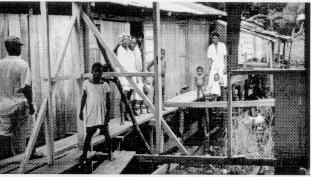Colombia's Internally Displaced
by Barbara Gerlach
 Remember
building block towers as a child and pulling out one block and
watching the whole structure crash to the ground? This summer I saw
the results of this kind of destruction on a massive social scale in
Colombia. Whole communities uprooted, a lifetime of work wiped out as
paramilitaries, funded by large landowners, business interests, and
drug cartels, have gone into resource-rich areas of Colombia and told
its inhabitants they have three days to "clean the zone."
Remember
building block towers as a child and pulling out one block and
watching the whole structure crash to the ground? This summer I saw
the results of this kind of destruction on a massive social scale in
Colombia. Whole communities uprooted, a lifetime of work wiped out as
paramilitaries, funded by large landowners, business interests, and
drug cartels, have gone into resource-rich areas of Colombia and told
its inhabitants they have three days to "clean the zone."
With a human rights delegation focusing on Colombia's displaced, I
visited an area known as Uraba, to the east of the Panama/Colombia
border, where the conflict among army, guerrilla, and paramilitary
groups is generating a mass displacement and an urgent need for
emergency humanitarian aid. There are about 10,000 newly-displaced in
Uraba alone. This is a resource-rich area, with many banana
plantations, oil, coal, gold, a mega-plan for development which
includes a "dry canal" consisting of a transcontinental
truck route south of the Panama Canal, two new ports on the Gulf of
Turbo, and a road to the sea extending the Pan American Highway. It
is also an important strategic point where drugs leave and arms enter
the country. The Afro-Colombians, indigenous peoples, and poor
campesinos who have lived in this coastal area for centuries, are the
casualties of this struggle for land and power. Bombs drop, troops
kill and intimidate, and the residents flee.
I visited San Jose de Apartado, a rural community of about 850
displaced, after most of its previous 1,500 residents fled an earlier
wave of violence. This community has declared itself a "community
of peace" and pledged to remain neutral with respect to all the
armed parties. They are hungry and afraid, under constant military
surveillance and intimidation from the paramilitaries, cannot go to
their fields to plant or harvest, and have been told that they will
be killed if they enter the cacao cooperative or use the processing
equipment they received from an organization in Holland.
I visited two sites in Turbo that have about 3,000 displaced and more
arriving every day. Many are living in a stadium or in plastic
shelters without enough food, water, or medical care. The Catholic
Church has built a shelter off the back of one of its churches and
has moved some of the families with children to this much more humane
living situation. We took testimony from the displaced about their
flight through the jungle, fording rivers, and the dismal living
conditions they now endure. They asked us to pressure the
international community for accompaniment to protect them,
humanitarian aid to help them survive, and a peace process to bring
the warring parties in Colombia to the negotiating table.
Human rights groups estimate that there are about 1,000,000 displaced
in Colombia: About 1/3 live in and around Bogota, and every day more
are arriving from almost every part of the country. At least 180,000
were displaced in 1996. Some have resettled in a semi-urban community
called Usme, springing up the side of the mountains south of Bogota.
I was able to visit this area and meet some of the displaced families
with the Mennonites and the Inter-Congregational Commission for
Justice and Peace, which is funded by 55 Catholic orders.
The good news is that I found the Church in Colombia--both the
Catholic and the Mennonite--functioning at a very high level,
documenting the human rights violations, working as a force for
peace, and responding to the overwhelming needs of the displaced. It
only takes three days to clear a zone and destroy a way of life, but
it will take many years, millions of dollars, and an "underground
railroad" of church workers to help the displaced Colombians
rebuild their lives.
Top/Arriba 
Index/Indice 
 Remember
building block towers as a child and pulling out one block and
watching the whole structure crash to the ground? This summer I saw
the results of this kind of destruction on a massive social scale in
Colombia. Whole communities uprooted, a lifetime of work wiped out as
paramilitaries, funded by large landowners, business interests, and
drug cartels, have gone into resource-rich areas of Colombia and told
its inhabitants they have three days to "clean the zone."
Remember
building block towers as a child and pulling out one block and
watching the whole structure crash to the ground? This summer I saw
the results of this kind of destruction on a massive social scale in
Colombia. Whole communities uprooted, a lifetime of work wiped out as
paramilitaries, funded by large landowners, business interests, and
drug cartels, have gone into resource-rich areas of Colombia and told
its inhabitants they have three days to "clean the zone."